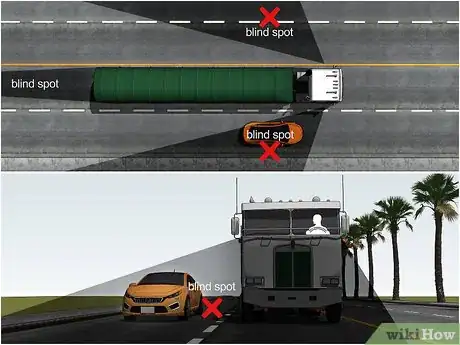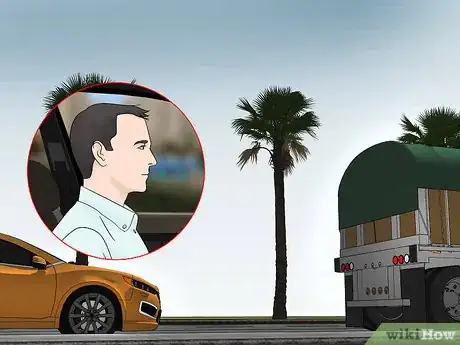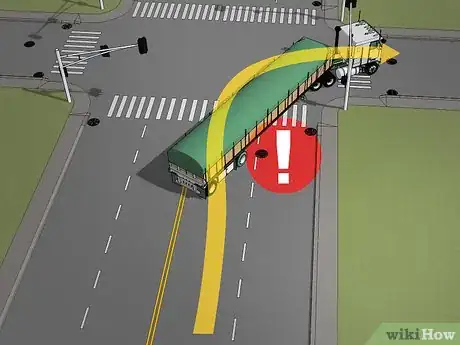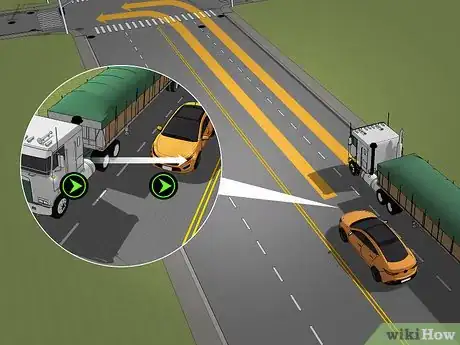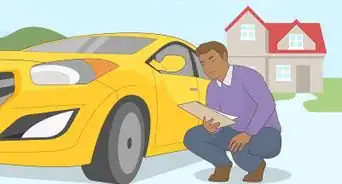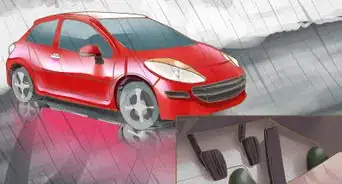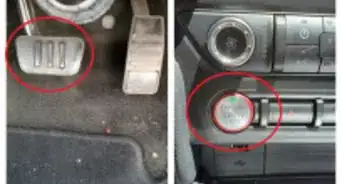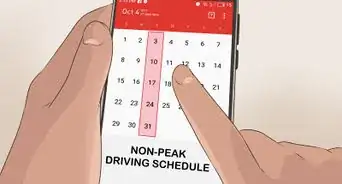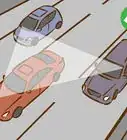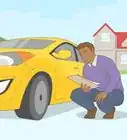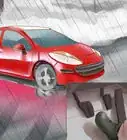This article was co-authored by American Automobile Association. The American Automobile Association (also known as "AAA" or "Triple A") is a federation of motor clubs throughout North America and a non-profit organization focused on the safety of the driving public and the future of mobility. Best known for providing its members with roadside assistance, AAA has also been providing auto repair services and insurance for auto, home, life, and business for over a century. Founded in 1902, AAA is headquartered in Heathrow, Florida.
There are 8 references cited in this article, which can be found at the bottom of the page.
This article has been viewed 124,853 times.
Though many assume truck drivers have a better view of the road because they are higher off the ground and have larger mirrors, trucks actually have bigger blind spots. Staying in a truck’s blind spot means that the truck driver cannot see you or your car, posing a huge safety risk and potentially leading to a serious accident. Learn where the blind spots are, give trucks plenty of space, and pass promptly to keep you and the drivers around you safe.[1]
Note: This article is based originally on right-hand traffic. Where it is not already clarified within the article, assume that you'll need to adopt the opposite side if applying these instructions to a left-hand traffic system.
Steps
Staying Aware
-
1Keep away from the sides of the truck. A truck’s increased size means bigger blind spots, so it is crucial to be aware of where these blind spots are. Sections of the lanes on either side of a truck, particularly on the right side, are not visible to the truck driver and therefore extremely dangerous for other cars to drive through.
- If you must drive through these areas to pass a truck, use caution and pass as quickly as safety allows. Signal early and let the driver see you before you pass.
-
2Make sure you can see the truck's side mirrors. If you can’t see the driver in their side mirror, it is likely that they can't see you either. Not being able to see the side mirrors indicates you are in a blind spot and should move out of that position as soon it is safe to do so.Advertisement
-
3Watch for signals. When driving behind a truck, you can’t see what is happening up ahead and must rely on the signals of truck driver in front of you. Stay observant and keep a close eye on the truck’s turn signals and brake lights so you can be prepared for them to stop or turn with some advance notice.
-
4Be patient with slow-moving trucks. Having a patient mindset can be just as crucial as staying aware of blind spots. Remember that trucks cannot maneuver as easily as smaller cars, which is particularly important in emergencies. Be cautious and respectful when driving around a truck to help keep yourself and everyone around you safe.
- Avoid honking (unless in an emergency situation), aggressive driving, and weaving through traffic, as these cause distraction and could ultimately result in a crash.[2]
Driving in Front of and Behind a Truck
-
1Give ample space when in front. Trucks cannot stop as quickly as a car or motorcycle, so it’s particularly important when driving in front of a truck to to give the truck driver plenty of space in case they do need to stop. If can see the truck’s headlights in your rearview mirror, you are out of the front blind spot and a safe distance in front of the truck.[3]
-
2Avoid tailgating. A truck’s large size means that truckers do not have rearview mirrors and must rely on side mirrors to see cars behind them. Driving behind a truck also means you cannot see what’s happening in front of them. Stay out of the no-zone directly behind the truck and give the truck plenty of space to slow down or stop.
- You should leave about 20-25 car lengths, or a four-second distance, between you and the truck in front of you.
- As often as possible, try to keep both of the truck’s side mirrors visible in front of you. This allows the truck driver to see you and be aware of you as well.
- In poor weather conditions, leave even more space between you and the truck.
-
3Take extra care when turning. Trucks will sometimes need to swing wide to make a turn, taking up additional lanes, so be extra aware if you are beside or behind a turning truck.
- Give the truck plenty of space.
- Don’t cut between the truck and the curb, and be aware that trucks cannot slow down as quickly as smaller vehicles.[4]
Passing a Truck
-
1Signal early. Passing a truck means you will have to go through a blind spot, however briefly. Show the driver you intend to pass as early as you can so they have enough time to see you and prepare for you to pass.
-
2Don't linger in the blind spots. Pass as promptly as possible and don’t linger in any of the truck's blind spots longer than necessary. This area is where you are in the most danger if a truck driver loses control, tries to change lanes, or gets into an accident.[5]
- Avoid passing on a truck’s right side. This is a truck’s worst blind spot because it extends further back and makes it even more difficult for a truck driver to see you coming up beside them.
-
3Give yourself room to merge. You should be at least two car lengths ahead of the truck before merging back into the same lane. This ensures that you stay out of the truck's front blind spot and helps you avoid cutting the truck off.
-
4Don’t slow down. After merging back into your lane in front of a truck, maintain passing speed and only slow down when you have a safe distance between you and the truck.
Community Q&A
-
QuestionWhat should I do when following a truck at night?
 Community AnswerKeep enough distance so that you have time to react if the truck slows down. If you don't plan on overtaking the truck, there isn't really anything you need to do aside from that (and make sure your lights are on, of course).
Community AnswerKeep enough distance so that you have time to react if the truck slows down. If you don't plan on overtaking the truck, there isn't really anything you need to do aside from that (and make sure your lights are on, of course). -
QuestionIf I am driving in the left lane and want to change to the right lane, what should I do?
 Community AnswerTurn on your right turn signal. Check your rear-view mirror and your right side mirror for cars. Check again. If you don't see any cars, glance quickly by turning your head to check your blind spot. If it is clear, gradually shift into the right lane. If you must cross multiple lanes, wait a few seconds between each lane change, and repeat all of these steps.
Community AnswerTurn on your right turn signal. Check your rear-view mirror and your right side mirror for cars. Check again. If you don't see any cars, glance quickly by turning your head to check your blind spot. If it is clear, gradually shift into the right lane. If you must cross multiple lanes, wait a few seconds between each lane change, and repeat all of these steps. -
QuestionIs it correct to say if you can see my blind spot I can't see you?
 Community AnswerBetter to know, "If I can't see your mirrors, then you can't see me." Best advice is to pause and give a truck extra space and time to make a maneuver.
Community AnswerBetter to know, "If I can't see your mirrors, then you can't see me." Best advice is to pause and give a truck extra space and time to make a maneuver.
Warnings
- If you're driving a truck, get out and check behind your truck before reversing it. If you have safety cones to denote a keep-out area that you're reversing into, make use of them.⧼thumbs_response⧽
- Never walk behind or drive around a truck that is reversing or preparing to reverse. The driver will not be able to see you, potentially leading to a fatal accident.⧼thumbs_response⧽
- Never cut in front of a truck that is slowing down to stop.[8]⧼thumbs_response⧽
- If you pass a stationary truck, reduce your speed just in case the driver steps out onto the road, as he or she may not be able to see you.[9]⧼thumbs_response⧽
References
- ↑ https://driversed.com/driving-information/sharing-the-road-with-others/blind-spots.aspx
- ↑ https://www.fmcsa.dot.gov/ourroads/tips-driving-safely-around-large-trucks-or-buses
- ↑ https://www.avvo.com/legal-guides/ugc/a-truck-driver-s-blind-spots-and-how-to-stay-out-of-them
- ↑ http://www.safeny.ny.gov/nozone.htm
- ↑ https://www.thetruckersreport.com/truck-blind-spots-know-the-danger-zones/
- ↑ http://www.dot.wisconsin.gov/safety/vehicle/truck/passing.htm
- ↑ http://www.nzta.govt.nz/resources/factsheets/34/sharing-with-trucks.html
- ↑ http://www.police.vic.gov.au/content.asp?document_id=9629
- ↑ http://www.nzta.govt.nz/resources/factsheets/34/sharing-with-trucks.html
